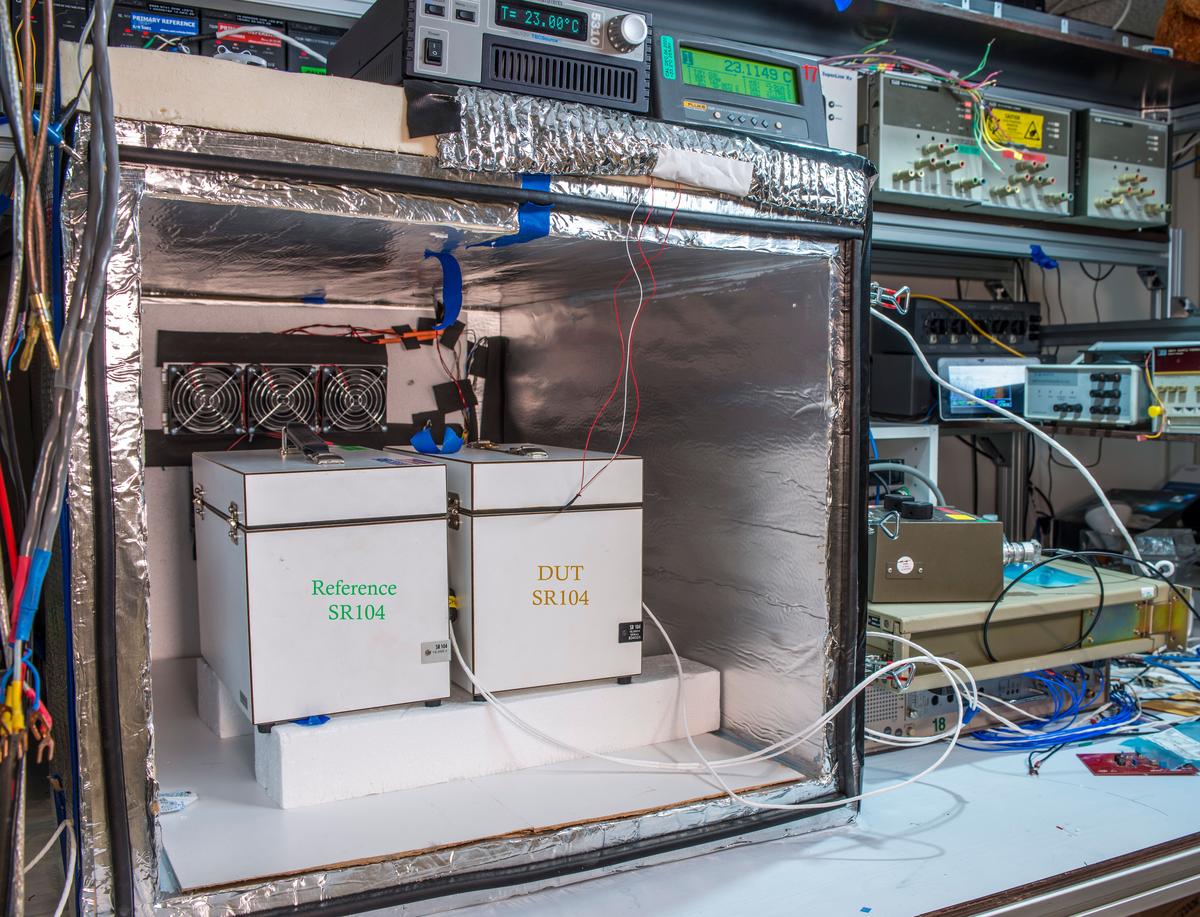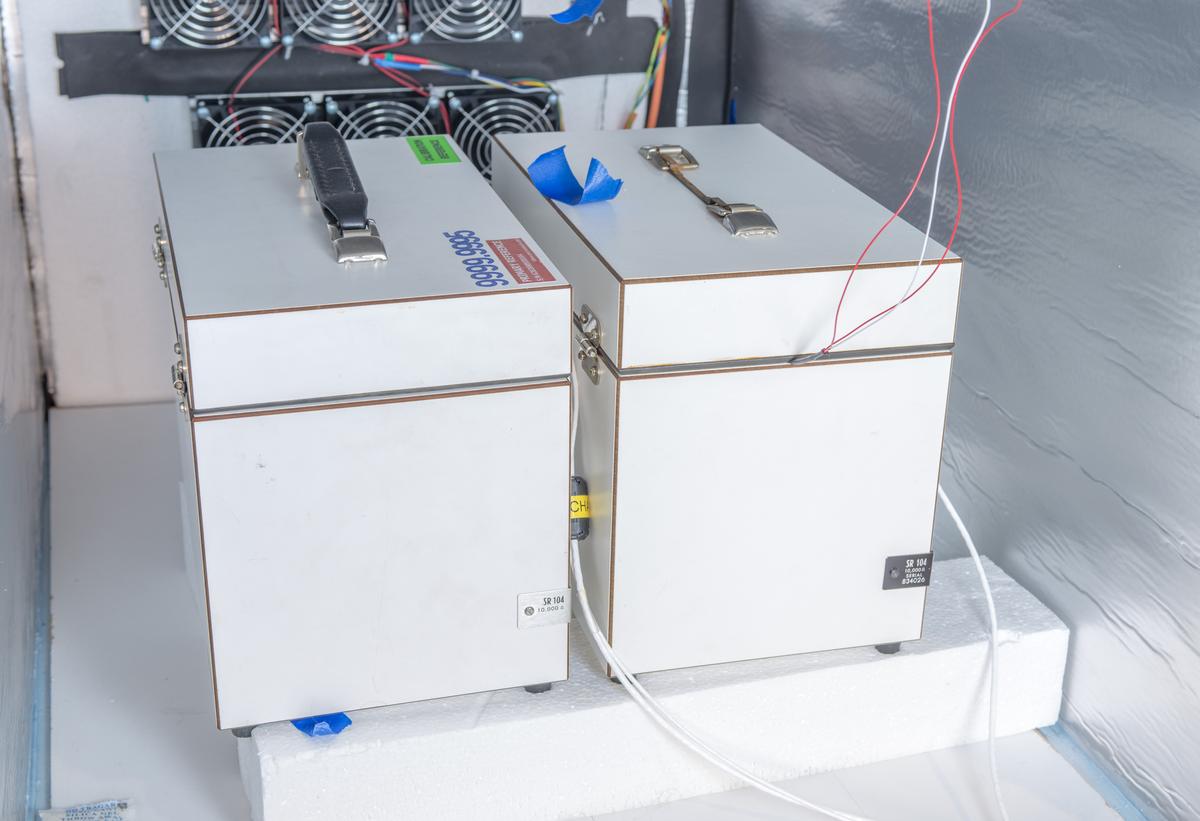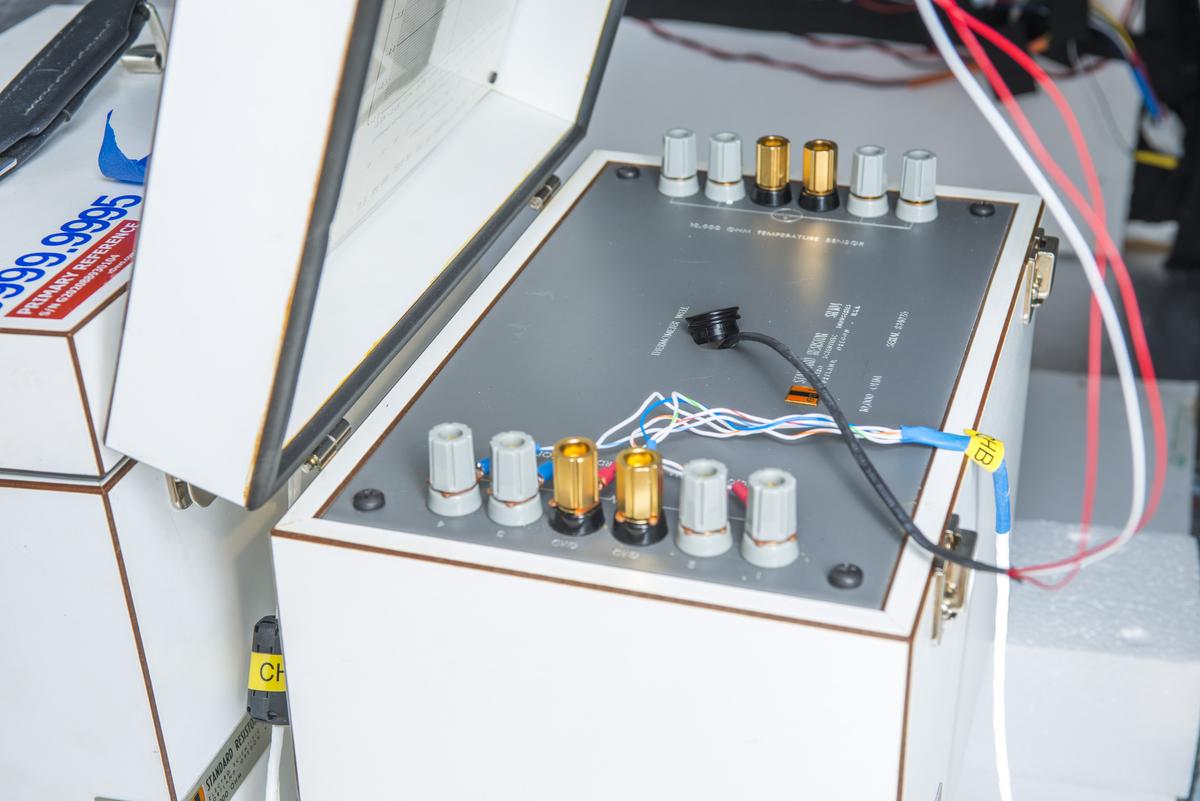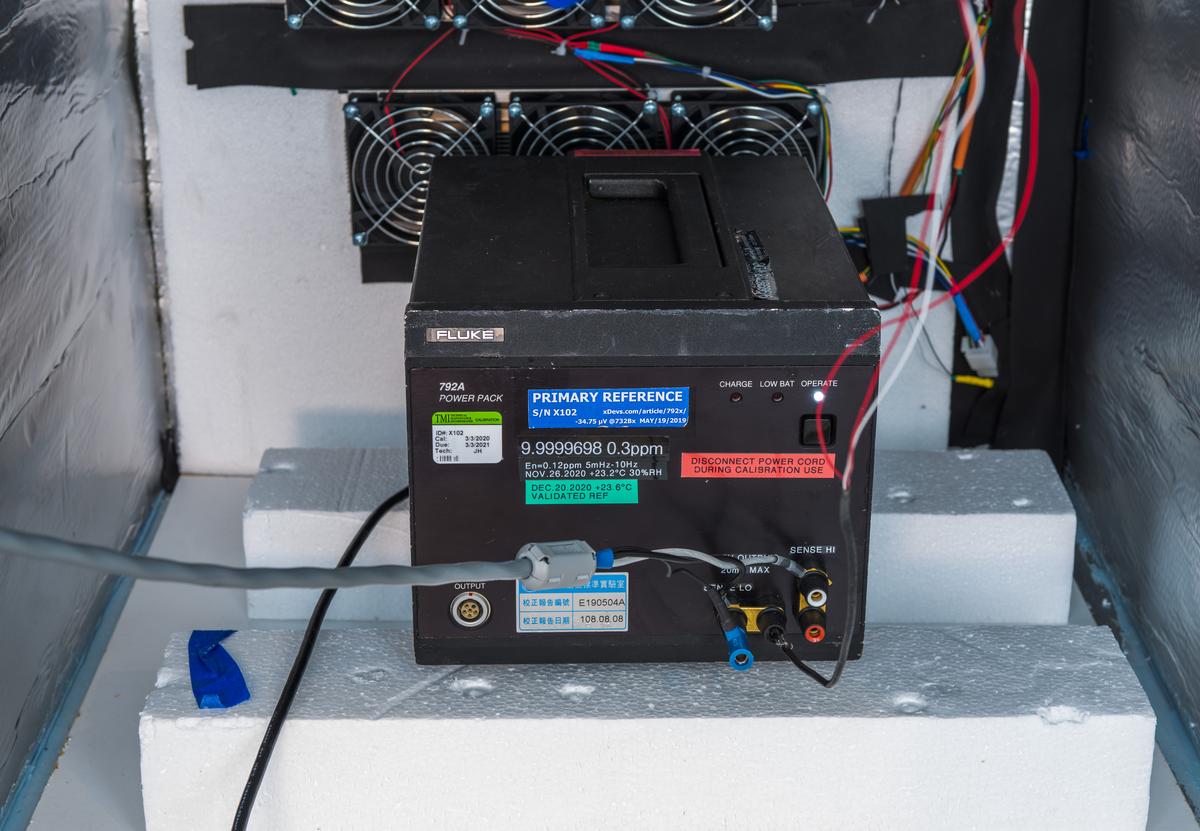-
MegaVolt
I'll take apart and modify N4-100 to unlock LTZ1000A capability some time in future. Overall assembly quality and component choice in this reference is mediocre.
I've already shared photos at xDevs IRC, so some people already seen it.
So far I'm quite impressed with performance of chamber, I expected much worse results for first run. PID controller settings are rather random (200, 0.02, 9.5) and nothing is tuned. Thanks to higher TEC power it is actually as fast as my previous Revision 5 chamber despite much much larger volume.
Will need to hook up different power supply (Sorensen 20V 50A) for booster stage and refine wiring for Arroyo, but all is very promising. Next DUT will be a 40W DMM which we can sweep from 18C to 28C for tempco. -
Next patient, 30W random DMM...
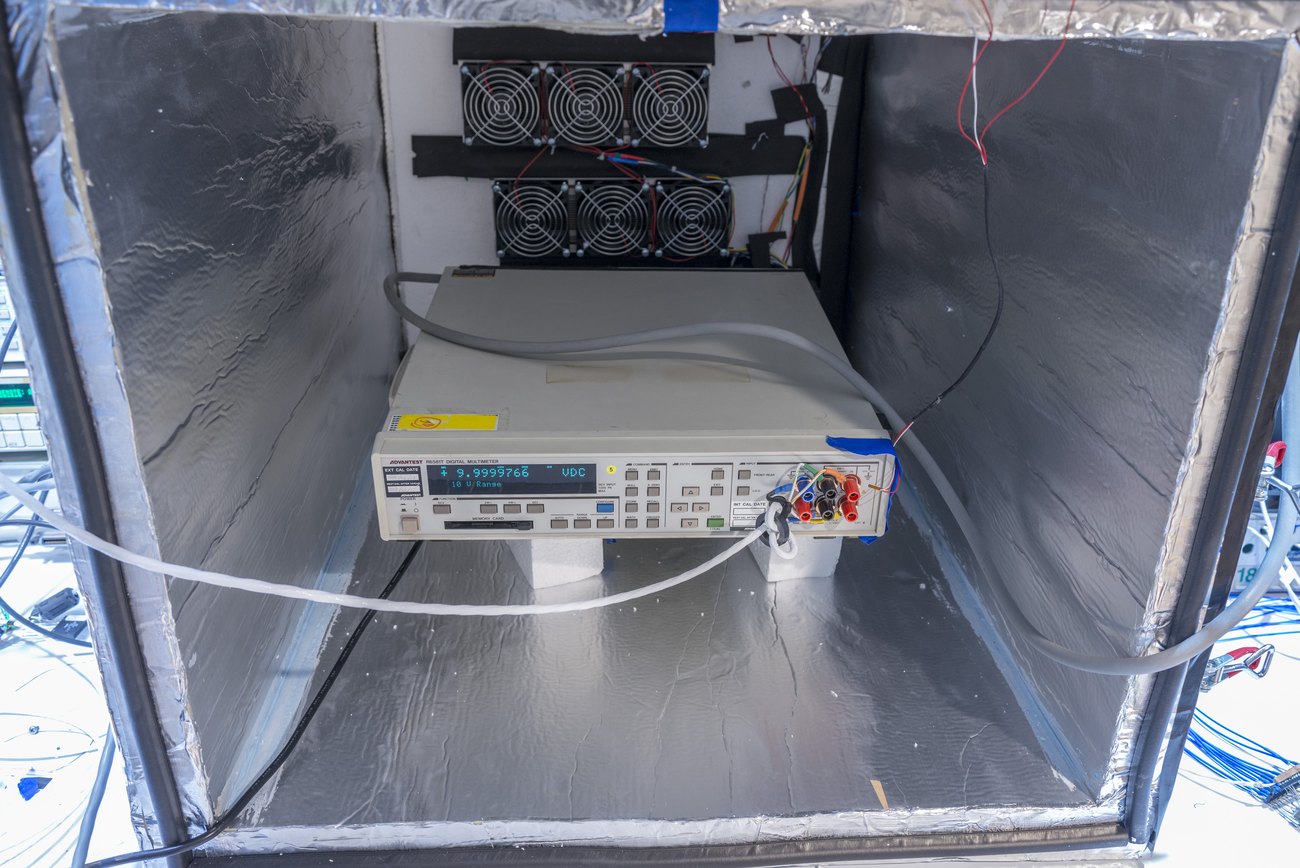
Cycle chamber temperature from +18.0 °C to +35°C and back in 20 hours, while logging 10VDC sourced from Hulk1 -
Chamber is happy to handle DMMs just fine. Here's a run from the above R6581T on 10V.
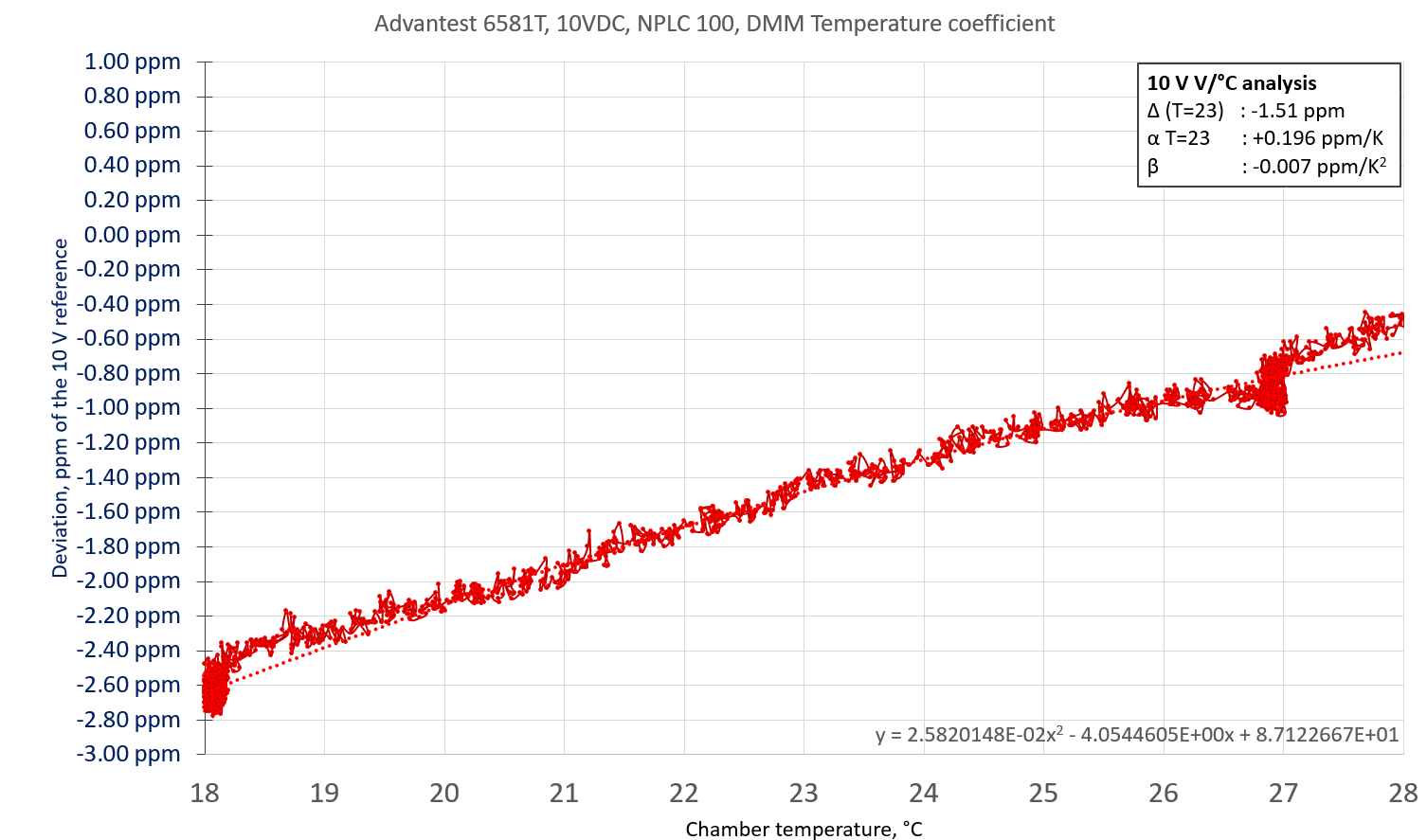
Not very good, but not horrible either.
Next patient, 8.5-digit Keithley 2002. To make it more interesting I have sourced multiple voltages and measured three ranges in sequence. Sequence is simple:
1. Select 200mV range, source 100mV into DMM, wait soak time for signal to settle, take a reading. Source and control 3458A outside of chamber also wired as reference.
2. Select 2V range, source 1V into DMM, wait soak time for signal to settle, take a reading. Source and control 3458A outside of chamber also wired as reference.
3. Select 2V range, source 2V into DMM, wait soak time for signal to settle, take a reading. Source and control 3458A outside of chamber also wired as reference.
4. Select 20V range, source 10V into DMM, wait soak time for signal to settle, take a reading. Source and control 3458A outside of chamber also wired as reference.
5. Select 20V range, source 20V into DMM, wait soak time for signal to settle, take a reading. Source and control 3458A outside of chamber also wired as reference.
Then repeat whole cycle on next step. Temperature was slowly increased and decreased with smooth ramp. There was a hold time at the middle (+27°C point) for 4 hours to see if any effects related to hysteresis/settling time in box.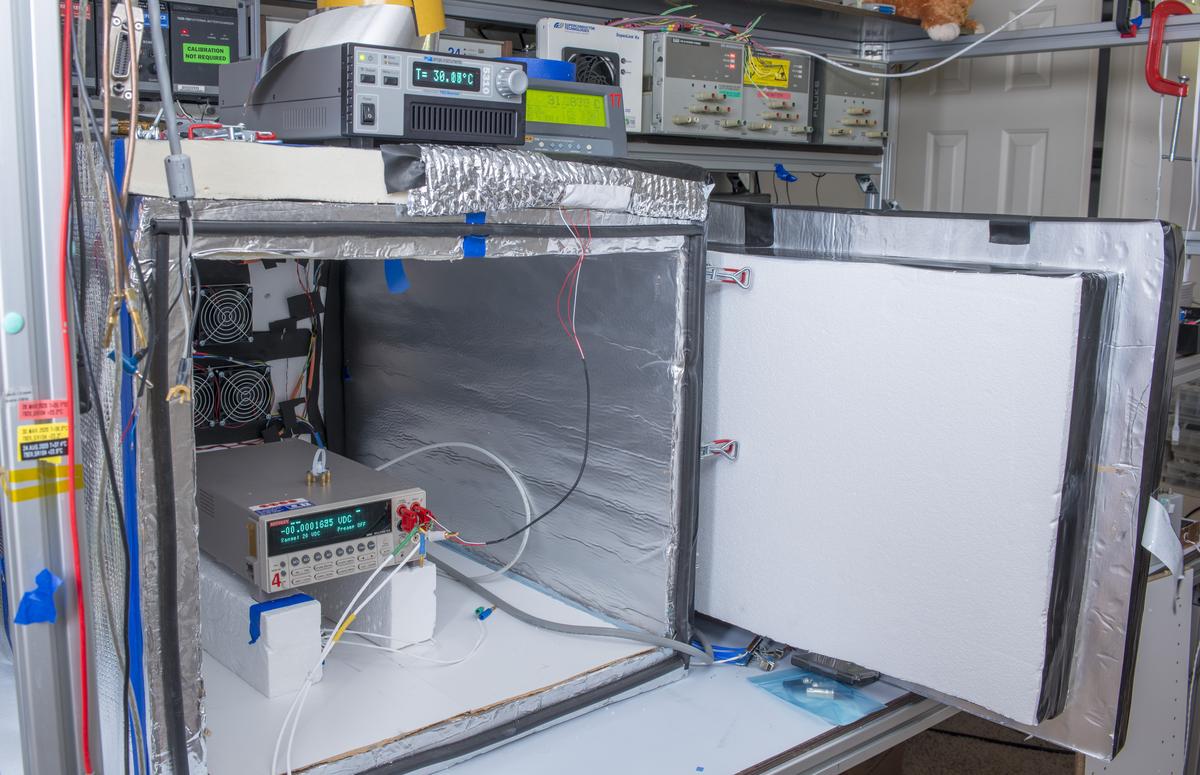
200mV range result is somewhat meh, but 2V and 20V ranges are quite impressive for a little meter. To give some perspective, most of HPAK 3458A's have worse temperature stability (without use of ACAL) than this 2002.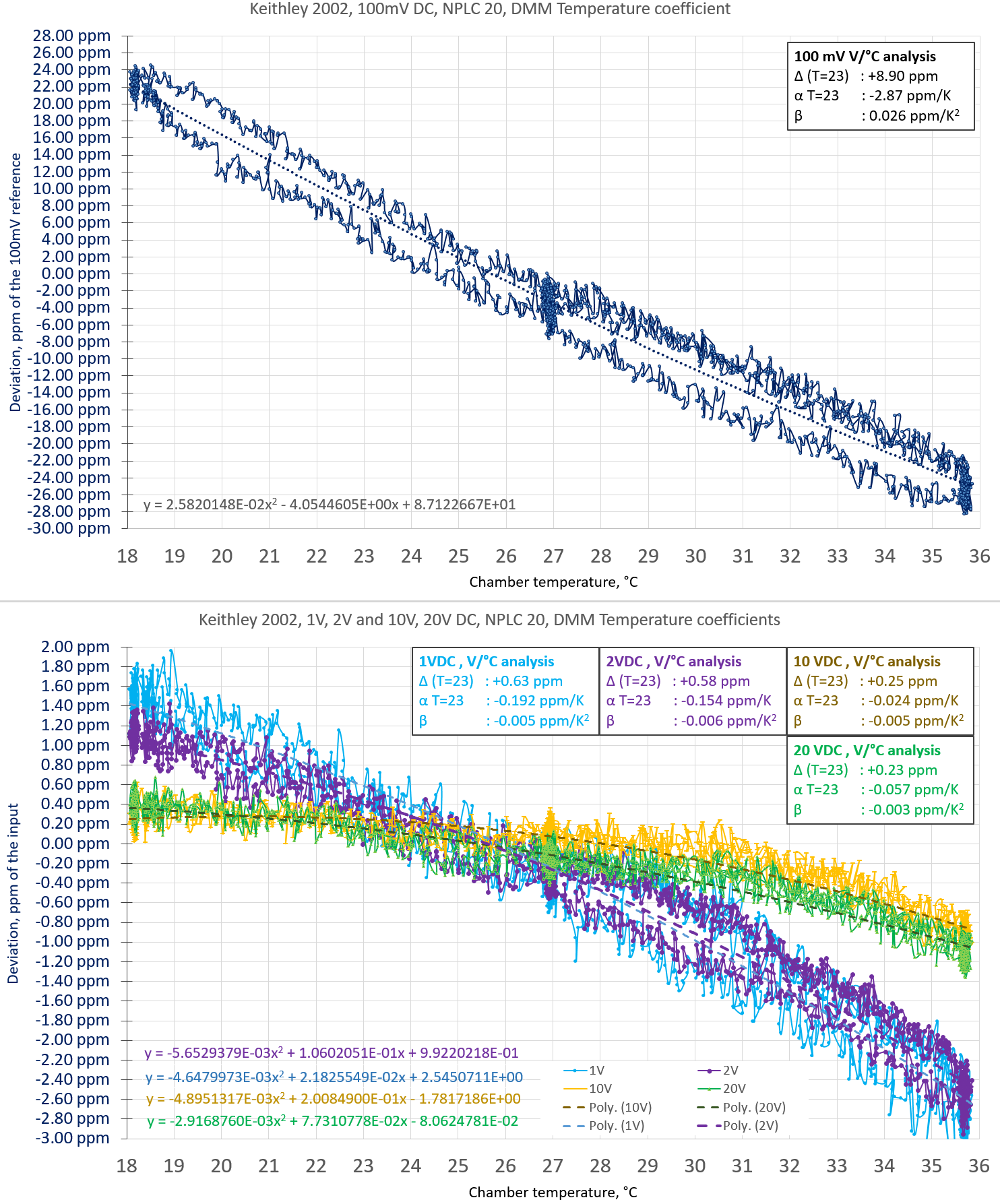
Now running more interesting unit which is famous for it's hot temper and 40W. Somebody may say that 8508A is filled with ultra-fancy highly-stable componentsand that's why it does not need ACAL hacks like cheap patchjob from competition. Well temperature sweep from +18 to +28°C will reveal the facts
... after 68 hours it need to perform smooth datalog.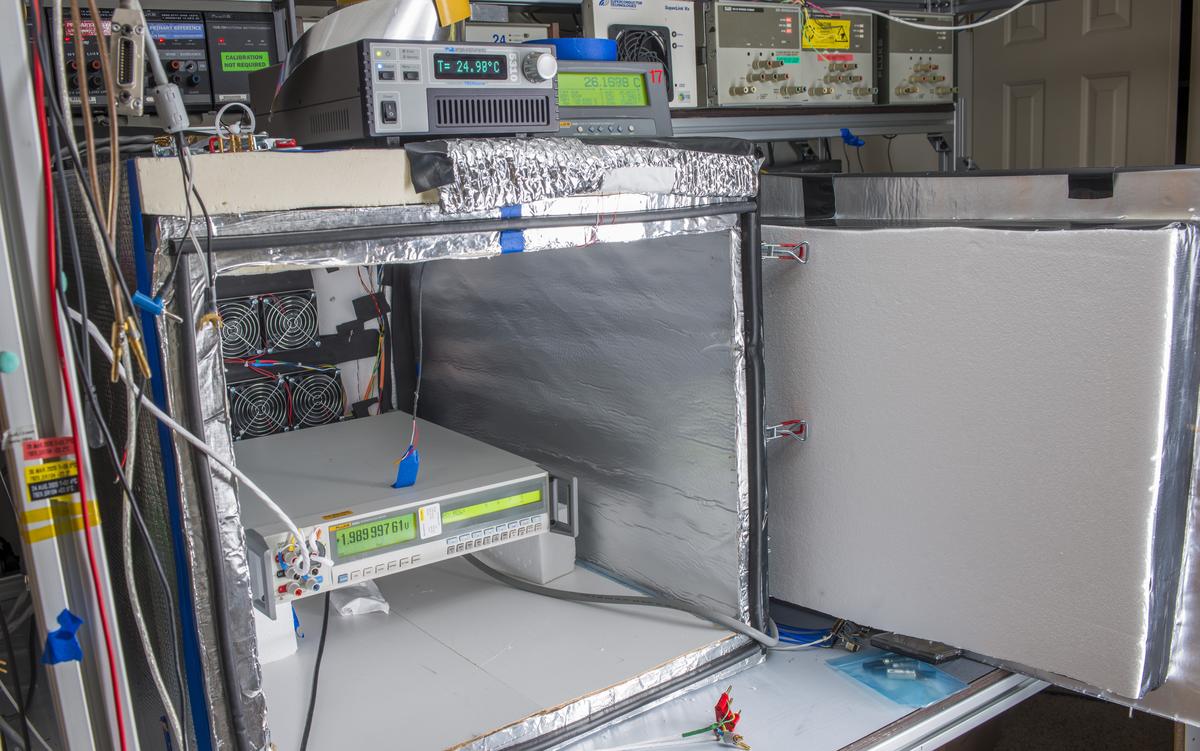
Now 8508A runs more points as well:Quotemeas_val = read_dcv_point(190e-3, 5, 190e-3)
meas_val2 = read_dcv_point(1, 5, 1.9)
meas_val3 = read_dcv_point(1.9, 5, 1.9)
meas_val4 = read_dcv_point(10, 5, 19)
meas_val5 = read_dcv_point(19, 5, 19)
meas_val6 = read_dcv_point(100, 5, 19)
meas_val7 = read_dcv_point(190, 5, 19)
meas_val8 = read_dcv_point(1000, 5, 1000)
meas_vbl = read_ohmf_point(1.9, 1, 1.9)
meas_vbl2 = read_ohmf_point(19, 1, 19)
meas_vbl3 = read_ohmf_point(190, 1, 190)
meas_vbl4 = read_ohmf_point(1.9e3, 1, 1900)
meas_vbl5 = read_ohmf_point(19e3, 1, 19000)
meas_vbl6 = read_ohmf_point(190e3, 1, 190000)
meas_vbl7 = read_ohmf_point(1.9e6, 1, 1.9e6)
meas_vbl8 = read_ohmf_point(19e6, 1, 19e6)

-
QUESTION: do you just put the DUT inside, turn it on, and start the test? Or do you put the DUT inside, turn it on, log data for several weeks at stabilized temperature, and then start the test?
Please, can you also post also a comparison graph at stabilized temperature? (And as you trust that your references, I will not ask about them). -
DMMs were powered on before as always, so yes, I just moved DMM into chamber, seal the door and then let Python program TEC setpoints for desired temperature, while DMM is used to log measured signal, sourced from Fluke 5720A. I had to ensure slow temperature change to allow internal temperatures in DMM track my set temperature. For K2002 tests temperature change speed is 0.018 °C/minute.
As of second question, I didn't quite understand, what you mean by comparison? I didn't run multiple DMMs in chamber at same time. -
It's all about the same question actually: the two weeks (or more) stabilization time needed by the meters before starting the test.
-
I never turn off any 8.5d meters or calibrators, so no need to wait.
-
Hello All,
I just wanted to recommend a company that my university colleagues use for their laser spectrometry assemblies. They measure gas emissions remotely for the petroleum industry that requires a high level of technical requirements and reliability as they travel internationally to perform analysis on-site at flares. (*In no way am I being sponsored here*)
TE Technology Inc. specializes in Thermo-Electric Cooling (TEC) modules, otherwise known as Peltier devices.
Check them out here: https://tetech.com/
Instead of spending thousands of dollars in an attempt to obtain ultra-precision (e.g. Arroyo Instruments with stability of ±0.004 °C https://www.arroyoinstruments.com/) which still requires a PSU and accessories, TE Tech offers a variety of controllers ranging from 140 USD to 720 USD with DYI achievable thermal control (±0.5 °C ~ ±0.01 °C, depending on the model). Most controllers can be interfaced with a computer, using their software. There are heaps of advantages to these economically priced units....
There's no control circuit as such to set the temperature, never got around to that yet. I just stick a temp probe through the side to record the internal temp.
Ian.
I tend to side with Ian Johnston, who has a modest setup that still gets the job done. We all have our own objectives in mind and I hope that this alternative gives you more flexibility in your environmental control design!
Regards. -
Good point, although high temperature stability doesn't seem too hard to DIY.
Myself, I bought a module from https://www.meerstetter.ch/products/tec-controllers/
It's working well. Took me perhaps an hour to get up and running.
TE Tech looks similar to Meerstetter, but with focus on higher currents.
My next step will be to computer-control the cheap Ruideng switching power supplies to create my own PID controller loop. They come in models up to 50V, 20A:
https://www.banggood.com/RIDEN-DPS5020-Constant-Voltage-Current-Step-Down-Communication-Digital-Power-Supply-Buck-Voltage-Converter-LCD-Voltmeter-50V-20A-p-1181200.html
Hopefully TECs don't mind the voltage ripple, investigated by multiple Youtubers. -
The TEC's don't mind a little ripple (like 10% the nominal current). Added ripple can still reduce the efficiency a little.
If doing the PID control yourself, I would recommend to also have a sensor on the other side of the TEC. The first reason is to detect a possible failure of the heat sink as protection. In addition the temperature of the other side may very well be one of a major sources of disturbance and one can directly correct for it in a feed forward mode, so improving on regulation. -
Time to cook some primary ESI SR104 resistance standards. These are planned to go for fresh calibration, so I figured obtaining tempco data prior shipping would be a good practical test of the large chamber. Also second ESI SR104 is used for ongoing interlab secret transfers between NJ and FL xDevs labs.
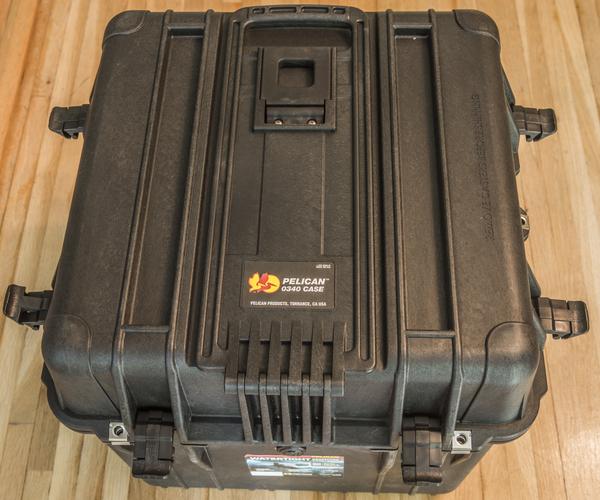

Standard was shipped in Pelican Cube 0340 foamed hardcase, to ensure minimal stress and shocks to sensitive standard. Externally standard is missing original handle. Instead it has just rusty metal strap attached.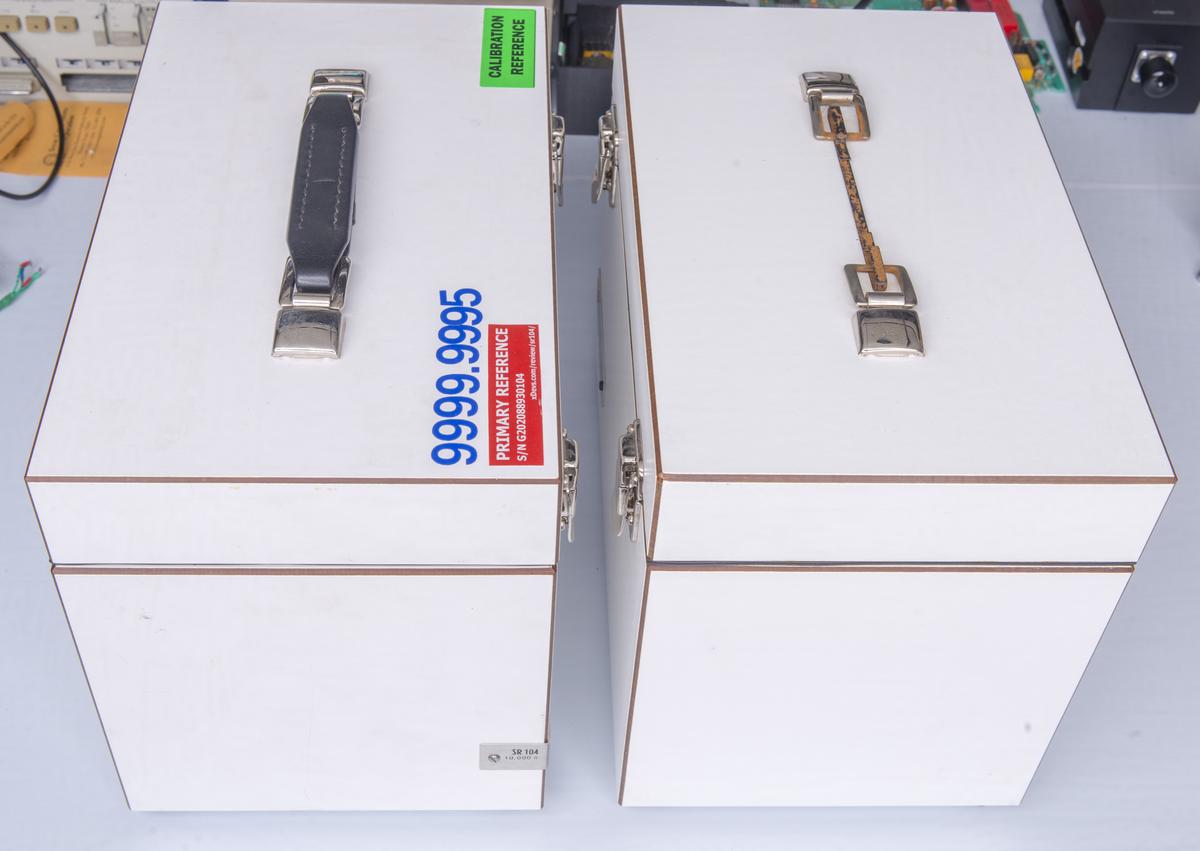
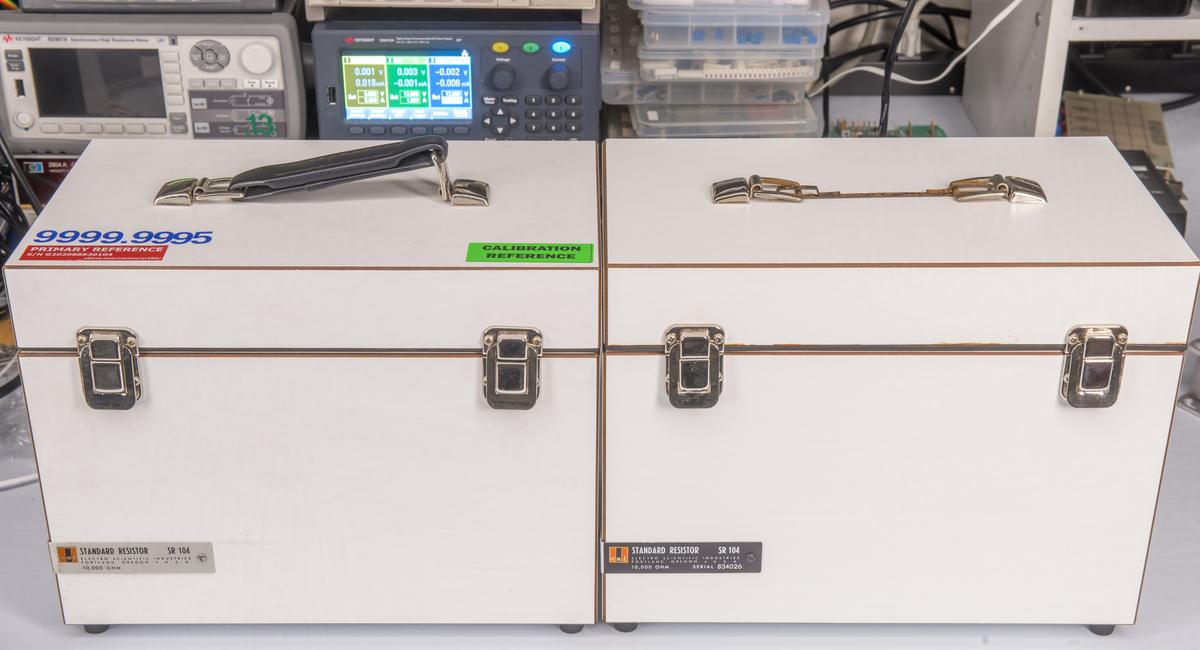
This unit is 20 years older than primary SR104 covered above, manufactured and calibrated on August 29, 1969. That is 52 years ago, to be exact!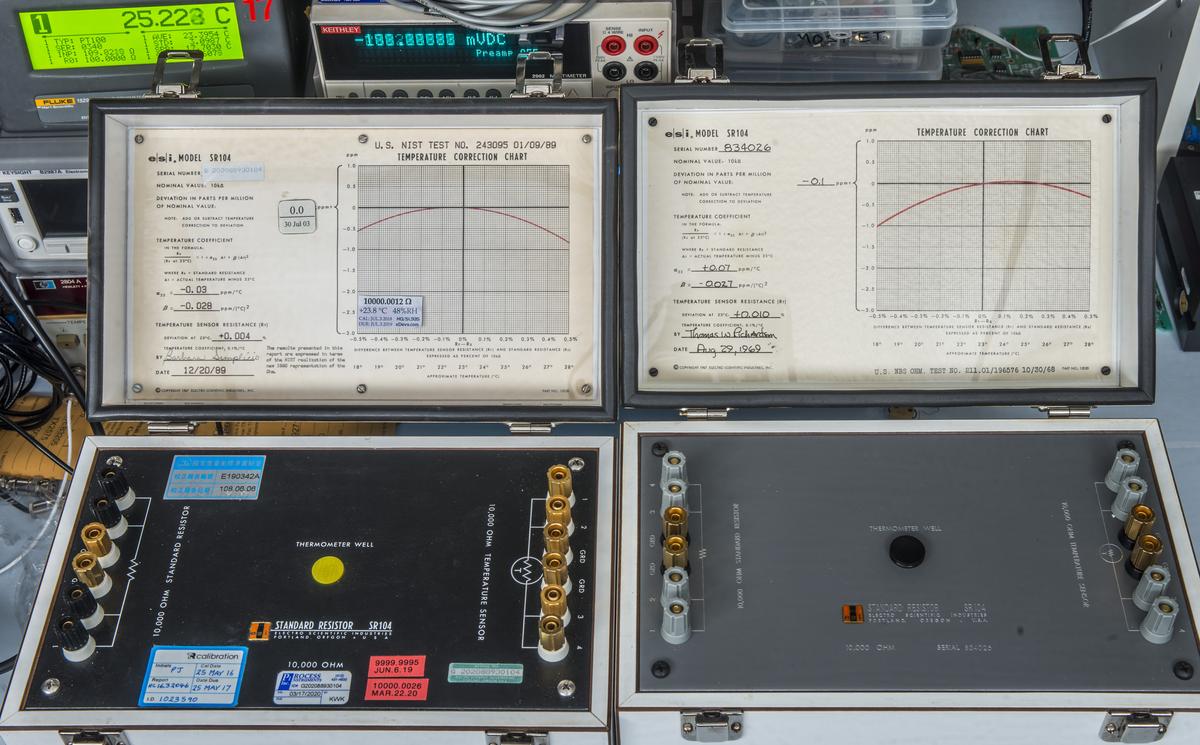
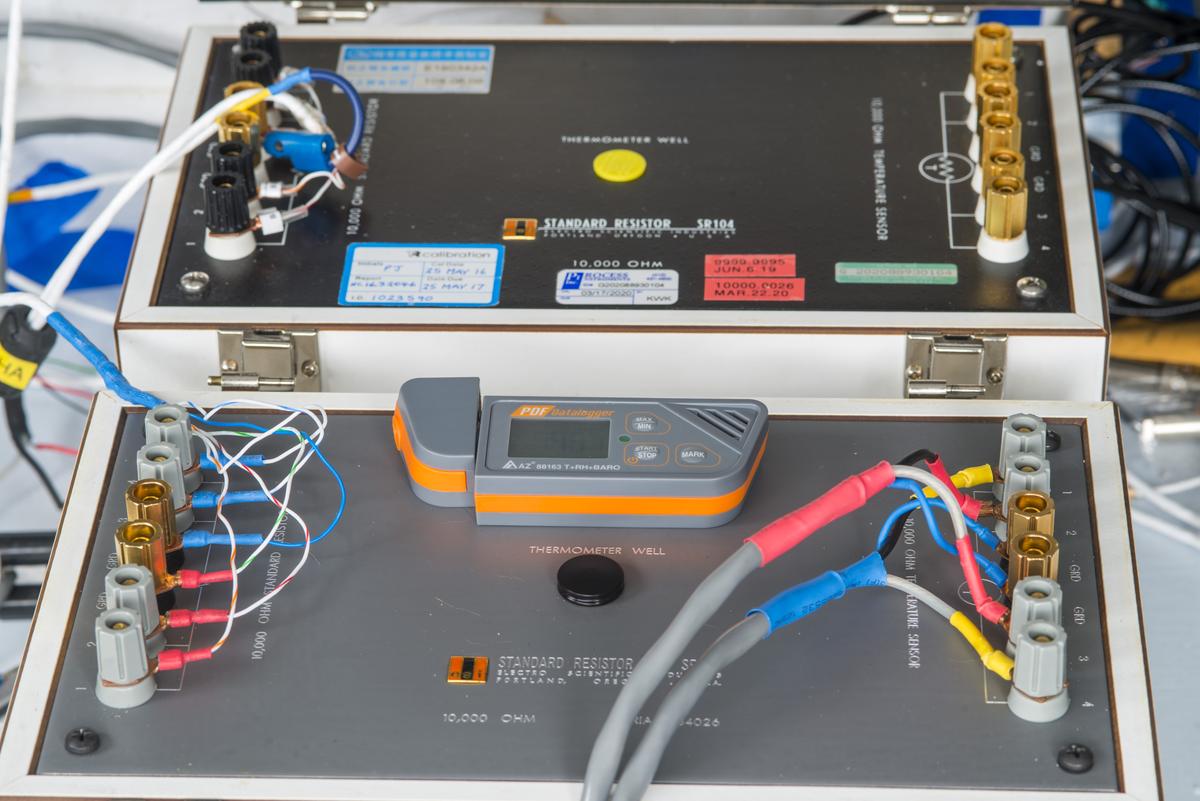
Measurements performed in our new large TEC-driven air bath xDevs.com chamber . Both SR104s were placed in chamber and wired to external Datron 1281 8½-digit multimeter . 3rd check standard (Fluke SL935) used as the verification source to ensure that Datron 1281 does not have stability or thermal coefficient issues on its own. All three used inputs on Datron 1281 were calibrated and corrected to obtain same reading to allow good resistance transfers with 3 standards.
Test run was automated using xDevs.com's Python app TECKIT and Keysight E5810A GPIB interface . Initial temperature in airbath was set to +18 °C then temperature was slowly increased to +23 °C where it was kept for 4 hours. Next temperature ramped to peak +28 °C to hold for 8 hours. Then thermal slope was reversed and final temperature +18 °C was obtained again. Temperature slope speed was fixed at 0.00694 °C/minute. Settings used for TECKIT are:
pre.. sv_start = 18.000 ; Chamber start temperature
sv_end = 18.000 ; Chamber end temperature
peak_temp = 28.000 ; Top soak temperature
delay_start = 0 ; Delay before any operation start, seconds
slope = 24 ; Hours, Time for slope (symmetric positive/negative) ramp
time_start = 12 ; Hours, Initial hold temperature time, before positive slope starts
time_dwell = 4 ; Hours, Dwell temperature duration time at peak-start/2 temperatures
time_hold = 8 ; Hours, Hold temperature duration time once reached peak_temp
time_end = 12 ; Hours, Final temperature duration once rampdown finished
slope_shape = lymex_step ; Advanced shape type, lymex_step = soak time_start in middle of the ramps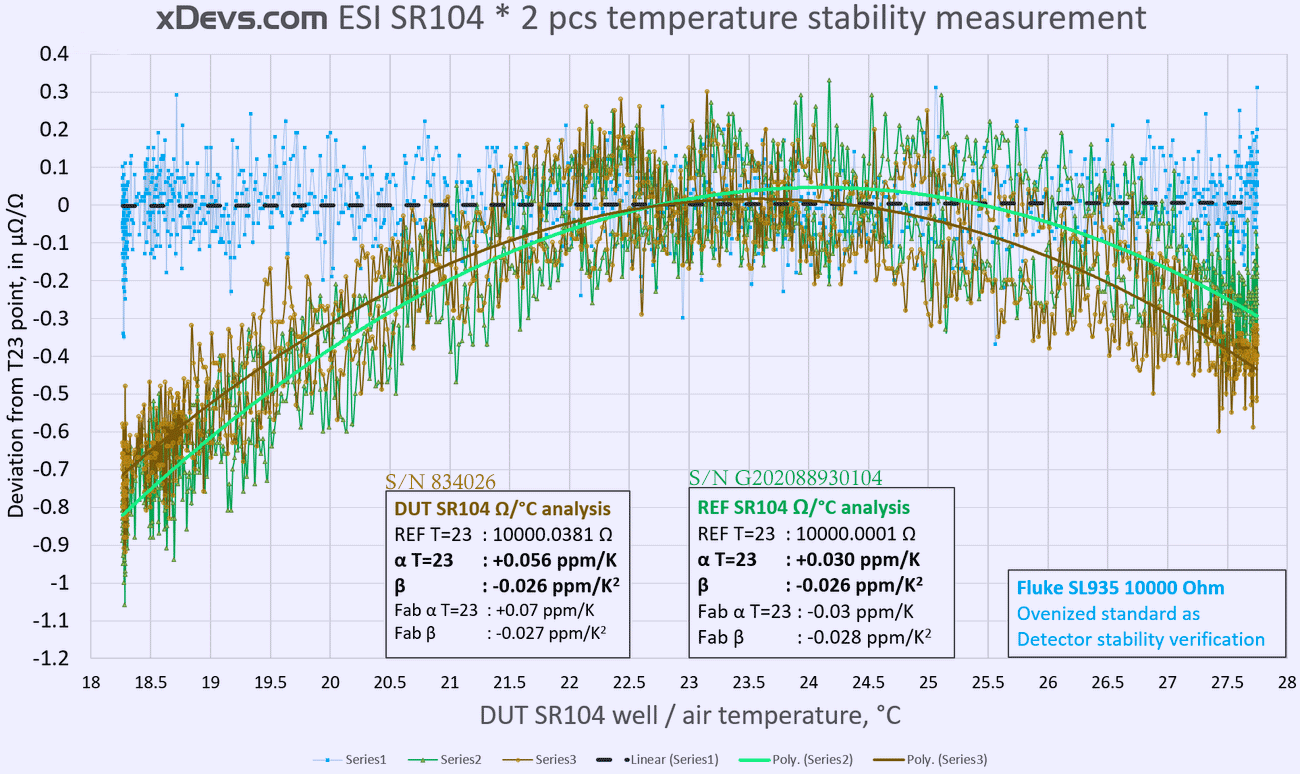
Results are pretty good. First we can notice relatively large amount of noise due to DMM internal current source and low voltage amplifier noise. Overall noise is about 0.3 ppm peak to peak. There is also slight hysteresis, which suggests that wirewound resistive element inside ESI SR104 may require some longer time to recover after 10 °C excursion. This test took 89 hours. Mostly such long time is due to large mass of the oil in SR104’s tank. Such mass caused long thermal delay around 9 hours during the test.
First we can check green reference SR104 data. It was last calibrated year ago by PI on 3/17/2020. Standard was assigned value 10000.0041 Ω at test current 300 µA with uncertainty ±0.15 ppm, but I have low confidence in this result, as previous history on this standard and our own measurement transfers suggest value around 10000.0026 Ω ±0.2 ppm instead. This standard will be recalibrated by high-end resistance laboratory in coming months and we can repeat measurements to obtain fresh traceable resistance reference at xDevs.com’s lab.
Back to results. Obtained measurement at temperature point +23 °C equals 10000.0001 Ω ±0.3ppm (K=1). Temperature coefficient from lid factory certificate is outlined on a plot with label “Fab α” and “Fab β” values. Measured and calculated α and β shown in bold font. Reference SR104 (green color on plot) have opposite sign α value but β match almost exactly.
52 year old ESI SR104 under test (“DUT” label and plot in brown color) has deviation from nominal +3.81 ppm (assigned value in result is 10000.0381 Ω ±0.85ppm). Measured and calculated α temperature coefficient value is slightly lower than factory (+0.056 ppm/°C vs +0.070 ppm/°C). β is almost exact match here as well. This standard will be also shipped for fresh calibration. -
Did you also placed that cute datalogger inside the TEC chamber to compare? How hot was the truck (or airplane?)?
-
The discrepencies in the fit parameters alpha and beta may be well inside your measurement uncertainties (noise, hysteresis). In order to check you could restrict the parabola fit to a +/- 2.5 °C range and compare the results. How much will the fit parameters shift?
Can't you use a temperature sensor with the SR104 thermometer well in order to reduce "hysteresis"?
Regards, Dieter -
dietert1
Hysteresis is not from temperature measurement. Temperature for analysis was taken from calibrated PT100 sensor placed in DUT SR104 well.
ramon
Temperature of DUT SR104 during transit was inside +18...+25°C range. Here's the log. You can spot two airplanes there
-
It's all off-topic, except maybe the question of whether someone plots against DUT temperature or air bath temperature. Your diagram says "air bath temperature". Can you show a plot of one temperature measurement against the other?
My other question was about dynamic range of "Large thermal chamber for T&M testing". I think that +/- 5 °C is a rather small dynamic range.
Regards, Dieter -
My bad about misleading label on plot. Correct should be "temperature in the SR104 well".
There is large delay (about 9 hours per °C) between airbath chamber temperature and internal SR104 temperature.
And no, I will absolutely not risk ruining annual stability of SR104s (<0.1ppm/year) by running outside of their designed +18°C - +28°C temperature range. It's VPG resistors that I run over 16-50c temperature without worrying much, but not the wirewounds that are used as lab primary standard .
.
I have running test of Datron 1281 own stability (same log, but now SR104s kept at constant +23.00 °C, while room temperature change by opening/closing window). Once that is finished, I'll take some photos of SR104 in chamber and temperature sensors location. -
I would like to share my experience with an extremely low-budget ON/OFF Heat or Cool temperature controller that I plan on using for the environmental chamber I posted previously. This setup is affordable to any enthusiast and suitable for beginners and experts alike.
The demonstration includes the following:
- Sanyo Denki DC axial fan for cooling a thermal probe
- A supply of at least 6 DCV (optionally, USB power) for the temperature controller
- Drok XY-T01 digital temperature controller (16 CAD from Amazon.ca) https://www.droking.com/Digital-Temperature-Controller-DC6.0-30V-Adjustable-Temperature-with-Heating-and-Cooling-Mode-Tester
- Sensirion SHT31 SMART GADGET (35 CAD from DigiKey) https://www.sensirion.com/en/environmental-sensors/humidity-sensors/development-kit/
The Drok can control temperatures to within "±0.1 °C" and can manage a circuit from 6 to 30 DCV at up to 10 A, which is ideal for most TEC (Peltier devices). The device has other configurations to control a relay and up to a 220 VAC circuit. The instrument is programmable and stores settings even when powered off.
[ Specified attachment is not available ]
The Sensirion can both precisely measure temperature and humidity which can be transmitted via Bluetooth to a phone APP then exported to a computer for analysis with Sensirion ControlCenter software. This provides an opportunity to own a very effective and inexpensive DAQ system, unlike my NI-cDAQ-9174 with the NI 9216 RTD module that costs over 2 grand.
When these evaluation boards are combined, you can completely control, monitor, and record your environmental control chamber for under 50 USD. The Control Center software is provided by Sensirion to evaluate the readings https://www.sensirion.com/en/controlcenter/.
Enjoy friends!
-
When these evaluation boards are combined, you can completely control, monitor, and record your environmental control chamber for under 50 USD.
Here is a quick update on the thermal control box that I am building. Keep in mind that the data being shared here is for a partially insulated 35 cm x 35 cm x 40 cm box with a single TEC mounted between two CPU water loops. The peak-to-peak oscillations are about ± 0.2 °C and there is clear overshooting, especially for the heating control. The operating temperature range is 17 to 35 °C when partially insulated. The control (response/lag-time is causing oscillations) and temperature range can be greatly improved by fullying insulating the box and by placing the temperature control probe directly on the TEC facing the inside. Apologies for the lack of cable management as the design remains incomplete. I cannot complain about a 50 USD investment for the controller and monitor. The thermal control box components are easily upgradable and the TEC accessible by removing 4 nuts on the top.
-
After your recommendation i also ordered that drok temperature controller. I'm surprised now about those oscillations, since i understood that controller has a 0.5 sec cycle time. Do you think you can modify the PID parameters to get stable regulation? In your setup, what is the distance between cooler/heater and temperature sensor of the drok?
Regards, Dieter -
Hi dietert1,
The oscillations are caused by thermal lag and can be resolved by placing the probe in close proximity to the TEC. The example I showed was about 35 cm away from the TEC, where the heat had to travel from water to air through the heat exchanger. The tuning parameters can be adjusted through the intuitive interface. Attached is a document that was provided with the DROK XY-T01.
If you look at my previous post, with the axial fan the oscillations are much less because the thermal lag time is very small. Neither setups are ideal because I haven't bothered with fine-tuning. This is a proof of concept for now. Note that the TEC is not current limited and is either 100 % ON (12 DCV at 6 A) or 0 % OFF, which is going to contribute to very drastic oscillations.
I hope this helps.
-
Did not read about PID parameters, but there is a hysteresis setting. So this controller can be a two point controller as well, similar to kitchen refrigerator. If the hysteresis was set to 0.1 °C, it would also oscillate with an amplitude of a little more than 0.1 °C. What setting did you use?
Regards, Dieter -
Did not read about PID parameters, but there is a hysteresis setting. So this controller can be a two point controller as well, similar to kitchen refrigerator. If the hysteresis was set to 0.1 °C, it would also oscillate with an amplitude of a little more than 0.1 °C. What setting did you use?
Regards, Dieter
The only important setting I adjusted was the 'temperature control precision', which I set to ± 0.1 °C. The temperature was corrected to coincide with the Sensirion as well -- it was a minor adjustment. Again, thermal lag time and the ON/OFF of 12 DCV @ 6 A can be optimized to reduce oscillations. Water has great heat capacity but poor heat absorption/desorption, combining that with 70 Watts of power from the TEC is going to make swings. -
The controller description looks like a simple 2 point regulator. So it is going simply on / off - which is not really the may to go for high precision. In addition the simple on OFF way is quite some stress to the TEC and the efficiency in the intermediate range is poor.
If the heat sink at the hot side is not very good, the temperature there will rise qith high operating current and thus lots of waste heat. This causes the current for the maximum cooling effect to be lower than the nominal number from the datasheet. So it may be better to lower the current, even if this is with just a series resistor.
For just a 2 point controller only 0.2 K swing is quite good, but still not really stable.
